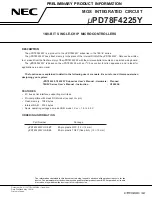
SBS System – SB-1000 Operation
3
which filters the signal by RPM. When an Auto-balance cycle is initiated, the control unit drives the two
balancer weights in the direction that reduces the amplitude of the incoming vibration signal.
Manual Balance Overview
The SB-1000 control can also be configured to be used as an aid in performing manual balance operations,
where the cost of a fully automatic system is not warranted. The SBS balancer is not needed when the
system is used in manual balance mode. Instead an RPM sensor is used to monitor the RPM and phase
position of the rotating spindle. An RPM signal not time synchronized to a physical location on the spindle
assembly (from the motor or other source) is not adequate to achieve balance. An RPM sensor with a fixed
position trigger point must be used to allow the phase position of the spindle to me determined.
Balance weights are either moved or added on the grinder manually by the operator as needed to achieve
balance. The SB-1000 assists the operator by analyzing the current balance condition of the grinder and
showing the operator how to position weights to achieve balance.
Environmental Considerations
The SBS Balance System is designed to correct for grinding wheel imbalance and its detrimental effects on
quality of surface finish, part geometry, and wheel and machine bearing life. The system cannot correct for
other environmental sources of vibration on the machine. This section is intended as a discussion of some
common environmental problems which may influence grinding quality.
Other Sources of Vibration
A common source of vibration is adjacent machinery. Grinding machines should be properly isolation
mounted if vibration-producing machinery is operating nearby. Other sources of vibration may also include
components mounted on the machine itself, such as pumps, motors, drives, etc.
The SBS Balance System may not operate efficiently under the influence of some external vibrations. The
system filters the vibration signal it detects from the grinding machine by the frequency of the spindle RPM.
Vibrations occurring at frequencies other than that of the rotating wheel will be ignored by the system.
However if adjacent machinery or auxiliary equipment on the grinder is operating near the same frequency as
the spindle rotation, the system will not be able to distinguish between vibrations occurring from wheel
imbalance and those originating elsewhere.
An excellent test for environmental vibration is to monitor the vibration level on the grinding machine while
the spindle is not turning. The vibration level should be checked in various locations on the grinding
machine, but in particular at the location the vibration sensor is to be mounted. All surrounding equipment,
including any auxiliary pumps or attachments on the grinding machine should be operating during this test.
The SBS Balance System can help perform this test but cannot remove these vibrations
(see: Background
Vibration section)
.
Machine Condition
Grinding machine condition is an important factor in determining the minimum balance level that the
SBS Balance System can achieve. The spindle should be balanced, as well as all components in the
spindle drive train (i.e. belts, pulleys, motor, etc.). The balance system can be used to readily determine
if any significant imbalance exists in the machine itself. Simply use the same method as described
above for checking environmental vibration, except test with the spindle running and with no wheel
mounted. The SBS Balance System cannot remove vibration resulting from machine condition
problems.










































